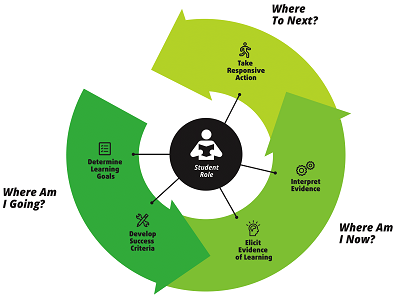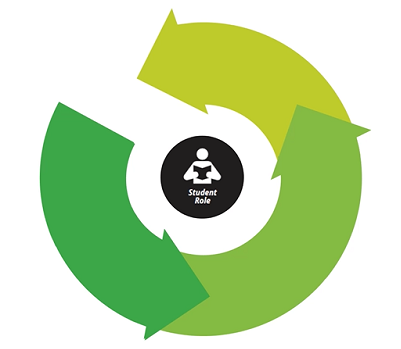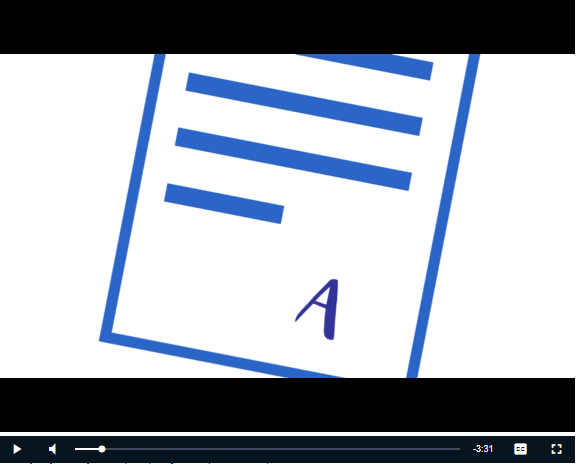Classroom Assessments
Useful classroom assessments provide information about grade-level learning
- The Minnesota K-12 Academic Standards outline the knowledge and skills each student is expected to learn by the end of a grade level or grade band.
- The Early Childhood Indicators of Progress (ECIPs), outline the expectations for learning from birth to age 5 years.
Schools and districts determine how their students will learn the standards by developing courses, curriculum, and instructional materials aligned to the standards.
Statewide assessments provide some of the information teachers can use to gain a sense of learning of standards-based content in reading, mathematics, and science. However, a teacher needs more fine-grained curricular information to differentiate instruction for individual and groups of students. Evidence from the classroom should always be considered when making decisions about curriculum, instruction and supports for students.
High quality classroom assessments provide teachers with actionable data to guide instruction
When formative assessments are aligned to standards-based learning goals and embedded throughout instruction, teachers can identify where students are at in their learning based on evidence, to guide them where to go next. Summative evidence of learning is usually collected at the end of a grading period. Both types of classroom assessment can help identify student misconceptions and scaffold future instruction. Learn more about the direct applications to grading, instructional improvement, learning acceleration and equity below.
Classroom Routines and Strategies
Formative Assessment: An evidence-based instructional strategy

The feedback loop above is an organizing framework for the five core practices of the formative assessment process:
- Developing daily learning goals that are aligned with academic standards
- Engaging students in developing and using success criteria, which involves working with students to better understand what they will be able to do when they have met the learning goal
- Eliciting and interpreting evidence of learning while it is developing, to better understand students’ current knowledge and skills
- Responding to evidence of student learning during lessons, and deepening the use of instructional strategies, such as feedback, questioning and prompting, that support students to move learning forward, and
- Teaching students to notice, interpret and use evidence, through new routines that engage students in peer feedback, self-assessment and discourse.
This process is most effective when students are engaged in each of these five practices during daily lessons. Outside of the feedback loop are three key questions that guide evidence use:
- Where am I going? For students to use evidence themselves, they must internalize what they will be able to make, do, say or write to show they have met the learning goal.
- Where am I now? Aligning the evidence gathered during learning with the daily learning goal is critical.
- Where to next? Learning is not “over” at the end of a lesson. Rather, teachers use the evidence to take pedagogical actions, while students identify strategies, they can use to keep learning moving forward.
Using Learning Goals and Success Criteria with Students
Research indicates that students who can identify and understand the learning expectations for a lesson are better prepared to support one another and take responsibility for their own learning. Students are also more likely to demonstrate their own learning when they understand what quality work actually looks like (success criteria).
- Video Gallery: Learning goals and success criteria in action
Routines for Eliciting Evidence
Eliciting evidence of student learning happens through the daily structures and activities of teaching and learning. There is no one single way to collect evidence. Observation, classroom talk, analysis of student work products and new questioning routines are some of the sources of evidence that teachers can intentionally use to find out where students are in their learning. With minor modifications to your own practice, these routines can quickly be put to use to gather information about how learning is progressing:
- Eliciting Evidence through Questioning - This article describes ways to engage students in questioning routines that support eliciting evidence, such as engaging in assessment conversations and using wrong answers to uncover student thinking.
- Five Evidence Gathering Routines - This article outlines ways to strengthen daily instructional practices, such as academic dialogue and analysis of student work, to elicit evidence.
- Eliciting Evidence: Routines and Insights - This article outlines six insights about using evidence ‘just-in-time,’ includes a high school science example
- Consider a routine outlined in the readings above. Reflect on what you might do differently during that routine in order to elicit evidence of student learning during a lesson. What might you apply right away from the readings to deepen your understanding of students’ current learning status?
Interpreting Evidence
- Student Work Analysis Protocol - Although teachers certainly review student work to provide a grade and perhaps to determine understanding of specific content standards, a systematic analysis that allows for determining instructional next steps is often missing from the teaching-learning-assessment practice. Teachers can use this resource to make a shift from scoring student work to evaluating student performance and using the information to guide instruction and scaffolds.
- Quick-Sort Protocol after a Pre-Assessment - This handout offers a simple strategy to use to interpret evidence and plan differentiated supports after gathering evidence from a pre-assessment.
- Additional formative assessment tools and strategies
- These tools and strategies can be embedded into any curriculum:
- 60 Formative Assessment Techniques
- Formative Assessment Classroom Protocols and Strategies
- These tools and strategies can be embedded into any curriculum:
Taking Responsive Action
- Six Attributes of Quality Feedback - Provides an overview of ideas to keep in mind to ensure that feedback helps move learning forward
- Deliberate Acts of Teaching - After teachers have interpreted the evidence and made a determination about the status of student learning, they need to take some action in response to students’ immediate learning needs. This action might be taken in the moment in the form of feedback to the student(s) or an instructional adjustment. This reading offers content-neutral ideas, but teachers can use it to consider how these ideas would apply to strengthen student learning in their content domains. Seven instructional adjustments are outlined that teachers can make in response to evidence gathered from the formative assessment process.
Instructional Planning Resources
Unit-Planning Resources
- Readiness Pre-Assessment
- Pre-Assessment Fundamentals (2/7/23) - this article explains the purpose, use, and recommended design process for pre-assessments: a way to collect information about what students already know and can do in relation to key prerequisite skills and concepts. Pre-assessment is critical to learning acceleration because it allows the teacher to utilize “just in time” instruction rather than remediating prior grade level standards separate from grade level work, by revealing students’ developing understandings relevant to a particular concept in an upcoming lesson.
- Readiness Pre-Assessment Tool (2/7/23) - this is a template teachers can use to design pre-assessments when planning a unit of instruction. Teachers can make a copy of the document and use it for planning to identify student strengths and needs related to pre-requisite knowledge and skills of the current and/or next unit of instruction.
- Unit-Planning
- Formative Assessment Unit-Planning Template (2/7/23) - This template can be used by teacher teams to embed quick formative assessments into their ongoing unit plan structure. An editable version can be downloaded by clicking on the 'Lesson Revision Protocol' below, so you can customize for your use. Examples for math, reading and science will be posted below based on the new Minnesota K-12 Academic Standards.
- English Language Arts (ELA) Grade 3
- English Language Arts (ELA) Grade 8
- Math PreK
- Math Grade 4
- Middle School Science
- Formative Assessment Unit-Planning Template (2/7/23) - This template can be used by teacher teams to embed quick formative assessments into their ongoing unit plan structure. An editable version can be downloaded by clicking on the 'Lesson Revision Protocol' below, so you can customize for your use. Examples for math, reading and science will be posted below based on the new Minnesota K-12 Academic Standards.
Lesson-Planning Resources for Embedded Formative Assessment
- Formative Assessment Lesson-Planning Template (2/7/23) - This lesson-planning template can be used by teachers to plan lessons that embed the process of eliciting, interpreting and responding to evidence of student learning. For additional guidance on using the template, review MnDAL Module 14: Planning Lessons in Formative Assessment. An editable version can be downloaded by clicking on the 'Lesson Revision Protocol' below, so you can customize for your use. Content specific examples are listed below.
- Math Grade 1
- Math Grade 4
- Math Grade 9
- Middle School Science
- Lesson Revision Protocol (2/7/23) - This is a protocol for taking lesson plans that already exist and modifying them to add high-quality components of formative assessment.
- Middle School Science Example
- PreK Example
Building Student Agency in Learning
The Student Role in Advanced Formative Assessment
(Building Student Agency in Learning)
The instructional routines of peer feedback, academic discourse, self-assessment and co-constructing success criteria all begin with a central idea – that students know how to talk about their learning. Establishing effective strategies for students to learn how to support one another’s learning is a first step in building classroom practices to support the students’ role in formative assessment.
- Discourse Fundamentals - This article outlines characteristic elements of productive student discourse and offers four principles to build students’ capacity to engage in discourse.
- The Student Role in Advanced Formative Assessment Practice - This article outlines foundational elements of student self-assessment, peer feedback, discourse and co-constructing success criteria.
- Building Blocks to Support Learner Agency - Outlines the definitions and differences between metacognition, self-efficacy, self-regulation, and learner autonomy
- Student Agency Progression - A two-pager outlining the continuum of shifts in student agency through engagement in the formative assessment process
Equitable Grading Practices
Equitable Grading Practices: One-Pager outlining recommended shifts from traditional grading practices toward more equitable policies and practices. For more information and related activities, enroll in the Minnesota Data and Assessment Literacy Online Module Series, Strand 2 for Leaders: Assessment Literacy
Professional Learning Activities and Resources
Online Learning Courses and Modules
Training Modules for Writing Assessment Questions
The training modules below support educators in developing a collection of assessment questions that are useful for guiding instruction. Although the modules are designed around multiple choice question types, the same best practices can be applied for writing or improving any question to gain insight about student understanding.
It is recommended to set aside an hour of time to work through the module, taking time to pause and reflect individually or discuss with colleagues.
Writing Multiple Choice Questions – MathematicsLength: 1 hour After completing this module, you will gain:
Posted March 2021
| Writing Multiple Choice Questions – ReadingLength: 1 hour After completing this module, you will gain:
Posted April 2021
|
Formative Assessment Professional Learning Activities
- Video Review Activity and Infographic: Understanding formative assessment and success criteria in action - This activity can be used in teacher Professional Learning Communities (PLCs) to see video examples of teachers, students, and leaders using success criteria. Links to the videos and reflection prompts are provided in the handout. This activity is modified from the MnDAL Course, Strand 3: Formative Assessment, Modules 10 and 11.
- Analysis of Formative Assessment in Practice: Elementary Math Lesson Vignette - In this learning activity, you’ll read a lesson vignette to explore how students engage in discourse, peer feedback and self-assessment. This lesson shows a “looped” grade 1 and 2 classroom in a dual-language program. At the time of filming, the teacher, Ms. Cardenas, had been implementing formative assessment for 10 years. In this classroom, students come from a range of social, economic, ethnic, and language backgrounds.
- Video Gallery and Individual Reflection: Shifts in Teacher and Student Roles - Download this guide to plan a professional learning activity that outlines the teacher and student shifts related to using evidence in formative assessment. You will use this document to review the videos, linked within, along with question prompts.
Animated Video: Summative assessment
Interim and Summative Resources
Animated video: Summative assessmentsAnimated video: Interim assessments
Resources for School and District Leaders
- Leadership Framework
- FARROP Tool - The purpose of this document is to provide guidelines and resources for use in peer observations and self-reflections on formative assessment instructional practices. Effective instruction addresses content understanding, elicits student thinking in depth, and makes adjustments in teaching, all while using the formative assessment practices described in this document. Rubrics for the implementation of formative assessment processes are included on pages 37-71.




